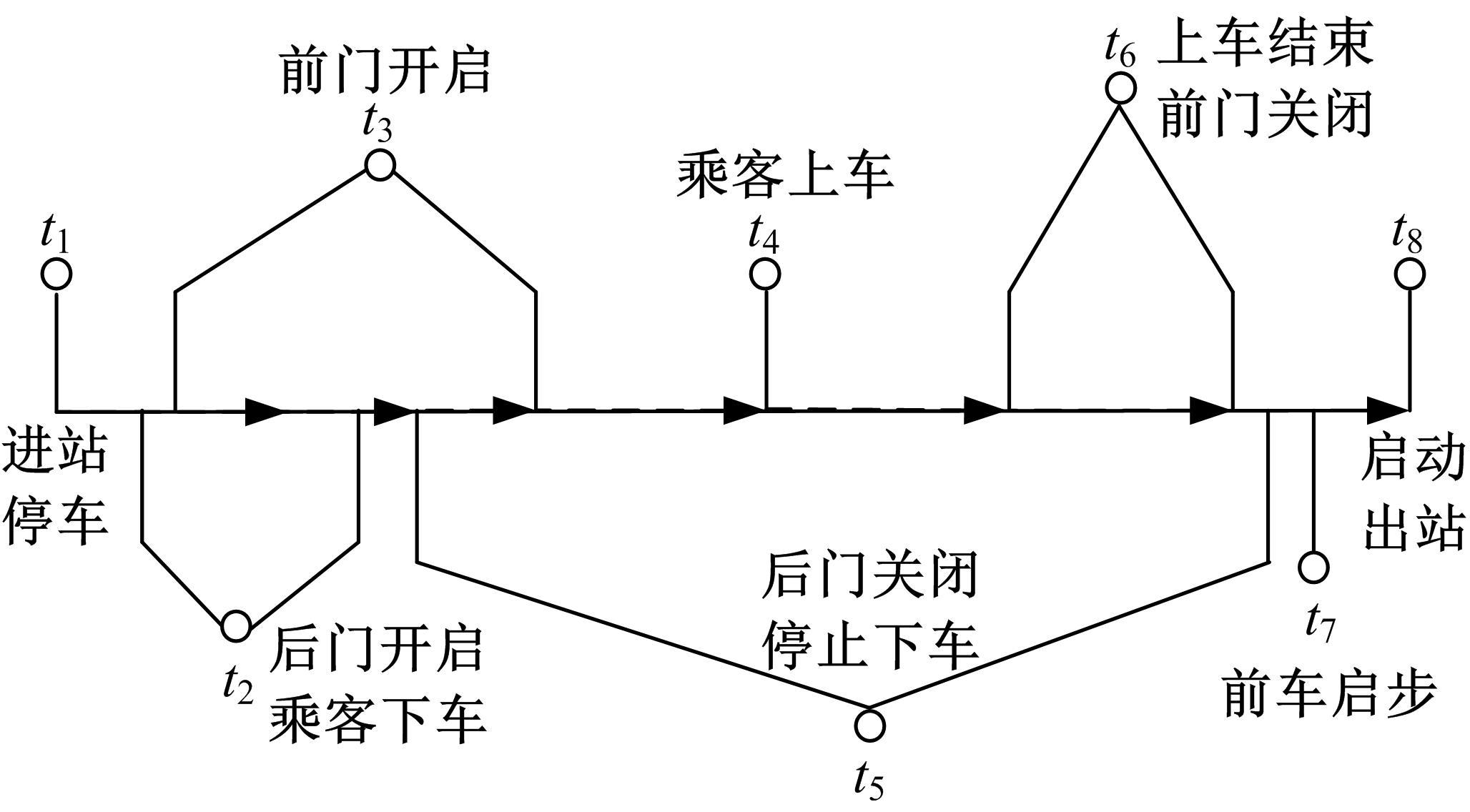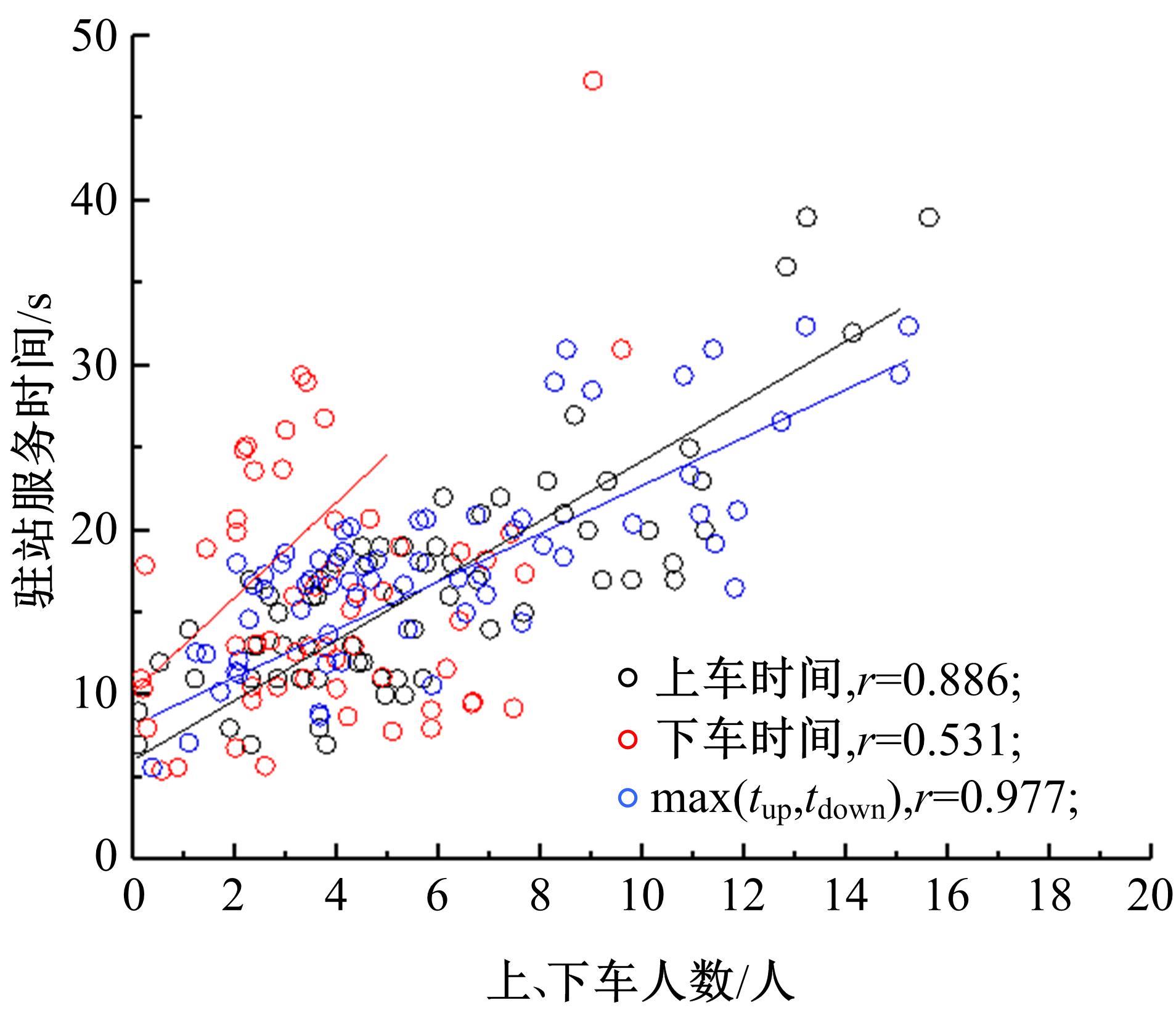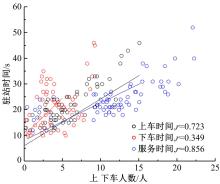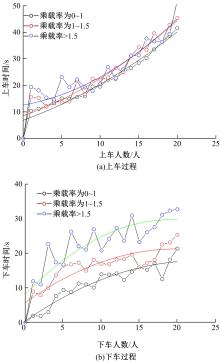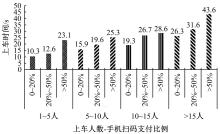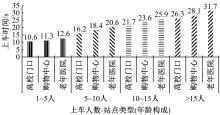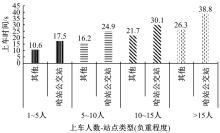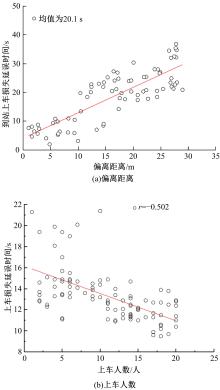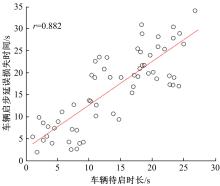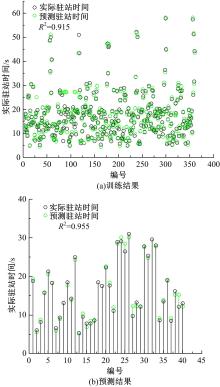Journal of Jilin University(Engineering and Technology Edition) ›› 2021, Vol. 51 ›› Issue (6): 2031-2039.doi: 10.13229/j.cnki.jdxbgxb20200676
Characteristics analysising and prediction of dwelling time of urban bus
Shi-jun YANG( ),Yu-long PEI(
),Yu-long PEI( ),Heng-yan PAN,Guo-zhu CHENG,Wen-hui ZHANG
),Heng-yan PAN,Guo-zhu CHENG,Wen-hui ZHANG
- School of Traffic and Transportation,Northeast Forestry University,Harbin 150040,China
CLC Number:
- U491.1
| 1 | Estrada M, Trapote C, Roca M, et al. Improving bus travel times with passive traffic signal coordination[J]. Transportation Research Record, 2009, 2111(1): 68-75. |
| 2 | Fan W D, Machemehl R B. Do transit users just wait for buses or wait with strategies some numerical results that transit planners should see[J]. Transportation Research Record, 2009, 2111(1): 169-176. |
| 3 | Peng Zhong-ren, Lyndem E, Chen Wei-ya. Understanding transit service gaps[C]∥The 89th Transportation Research Board Annual Meeting, Washington DC, 2009: 1-18. |
| 4 | Khoo H L. Statistical modeling of bus dwell time at stops[J]. Journal of the Eastern Asia Society for Transportation Studies, 2013, 10: 1489-1500. |
| 5 | Chen Shao-kuan, Zhou Rui, Zhou Yang-fan, et al. Computation on bus delay at stops in Beijing through statistical analysis[J]. Mathematical Problems in Engineering, 2013, 2013(1971): No.745370. |
| 6 | Tirachini A. Bus dwell time: the effect of different fare collection systems,bus floor level and age of passengers[J]. Transportmetrica A: Transport Science, 2013, 9(1):28-49. |
| 7 | Arhin S A, Noel E C. Predicting dwell time by bus stop type and time of the day[J]. Journal of Civil & Environmental Engineering, 2015, 5(5): No.1000189. |
| 8 | 梁士栋,赵淑芝,马明辉,等. 路段直线式公交站点对公交车延误的影响[J]. 吉林大学学报:工学版,2016,46(6):1807-1817. |
| Liang Shi-dong, Zhao Shu-zhi, Ma Ming-hui, et al. Impacts of linear bus stop on bus delays[J]. Journal of Jilin University(Engineering and Technology Edition), 2016, 46(6): 1807-1817. | |
| 9 | 王旭,陈旭梅,寇伟彬,等. 公交站点停靠时间预测模型研究[J]. 交通信息与安全,2016,34(2):55-61. |
| Wang Xu, Chen Xu-mei, Kou Wei-bin, et al. A prediction model of bus dwelling time at the stops[J]. Journal of Transport Information and Safety, 2016, 34(2): 55-61. | |
| 10 | 吕伟,李志红,赵彩虹,等. 城市公交车停靠时间特征的观测试验与实证研究[J]. 公路交通科技,2019,36(11):90-96. |
| Lü Wei, Li Zhi-hong, Zhao Cai-hong, et al. Observation experiment and empirical study on parking time characteristics of city buses[J]. Journal of Highway and Transportation Research and Development, 2019, 36(11): 90-96. | |
| 11 | 邓媚,李春达. 不同站台环境下公交车停靠时间的动态预测模型[J]. 重庆交通大学学报:自然科学版,2019,38(12):105-109. |
| Deng Mei, Li Chun-da. Dynamic prediction model of bus dwell time under different station conditions[J]. Journal of Chongqing Jiaotong University(Natural Science), 2019, 38(12): 105-109. | |
| 12 | 朱文韬,钱国敏,马东方,等. 考虑路口上游停靠站影响的公交延误模型[J]. 浙江大学学报: 工学版,2020,54(4):796-803, 815. |
| Zhu Wen-tao, Qian Guo-min, Ma Dong-fang, et al. Bus delay model considering influence of stop at upstream of intersection[J]. Journal of Zhejiang University(Engineering Science), 2020, 54(4): 796-803, 815. | |
| 13 | 马尚萱. 常规公交站点停靠时间分析与预测方法[D]. 南京:东南大学交通学院,2016. |
| Ma Shang-xuan. Bus dwell time analysis and prediction methods[D]. Nanjing: School of Transportation, Southeast University, 2016. | |
| 14 | 陈亮,冯柳,李巧茹. 考虑在车感知价值的公交发车间隔计算模型[J]. 哈尔滨工业大学学报,2018,50(3):150-155. |
| Chen Liang, Feng Liu, Li Qiao-ru. Bus departure interval model considering on-bus perceived value[J]. Journal of Harbin Institute of Technology, 2018, 50(3): 150-155. | |
| 15 | Group KFH. Transit Capacity and Quality of Service Manual[M]. 3th ed. Washington DC: TRB, 2013. |
| 16 | 姜桂艳,刘彬,隋晓艳. 基于IC卡收费系统的公交客流信息实时采集方法[J]. 吉林大学学报:工学版,2016,46(4):1076-1082. |
| Jiang Gui-yan, Liu Bin, Sui Xiao-yan. Real time information collection of passenger flow in public transportation based on bus IC card charging system[J]. Journal of Jilin University(Engineering and Technology Edition), 2016, 46(4): 1076-1082. | |
| 17 | 刘莹,于淼,刘阳. 基于乘客感知的公交车线路服务质量评价模型[J]. 东北大学学报:自然科学版,2019,40(5):750-755. |
| Liu Ying, Yu Miao, Liu Yang. Evaluation model of bus Route service quality based on passengers perceptions[J]. Journal of Northeastern University(Natural Science), 2019, 40(5): 750-755. | |
| 18 | Liu Y. An improved AHP and BP neural network method for service quality evaluation of city bus[J]. International Journal of Computer Applications in Technology, 2018, 58(1): 37-44. |
| 19 | 罗菊,方照东,袁泉.基于集成神经网络的信道估计方法研究[J].重庆邮电大学学报:自然科学版,2020, 32(6): 969-975. |
| Luo Ju, Fang Zhao-dong, Yuan Quan. Research on channel estimation method based on integrated neural network[J]. Journal of Chongqing University of Posts and Telecommunications(Natural Science Edition), 2020, 32(6): 969-975. | |
| 20 | 李娜娜, 胡坚剑, 顾军华, 等. 深度置信网络优化模型在人才评价中的应用[J]. 计算机工程, 2020, 46(2): 80-87, 102. |
| Li Na-na, Hu Jianjian, Gu Jun-hua, et al. Application of optimized deep belief network model in talent evaluation[J]. Computer Engineering, 2020, 46(2): 80-87, 102. | |
| 21 | 张飞,雒江涛,何宸,等. NDN中基于神经网络的兴趣洪泛攻击综合防御方案[J].重庆邮电大学学报:自然科学版, 2020, 32(2): 177-184. |
| Zhang Fei, Luo Jiang-tao, He Chen,et al. Evaluation model of bus Route service quality based on passengers perceptions[J]. Journal of Northeastern University(Natural Science), 2020, 32(2): 177-184. |
| [1] | Xiao-hua ZENG,Mei-jie SONG,Da-feng SONG,Yue WANG. Data processing method of bus driving cycle based on vehicular network information [J]. Journal of Jilin University(Engineering and Technology Edition), 2021, 51(5): 1692-1699. |
| [2] | Xiao-dong ZHU,Qi-xian ZHANG,Yuan-ning LIU, WU-di,Zu-kang WU,Chao-qun WANG,Xin-long LI. Iris recognition based on multi⁃direction local binary pattern and stable feature [J]. Journal of Jilin University(Engineering and Technology Edition), 2021, 51(2): 650-658. |
| [3] | Tian-qi GU,Chen-jie HU,Yi TU,Shu-wen LIN. Robust reconstruction method based on moving least squares algorithm [J]. Journal of Jilin University(Engineering and Technology Edition), 2021, 51(2): 685-691. |
| [4] | Xian-min SONG,Ming-ye ZHANG,Zhen-jian LI,Xin WANG,Ya-nan ZHANG. Setting of dynamic bus lane and its simulation analysis and evaluation [J]. Journal of Jilin University(Engineering and Technology Edition), 2020, 50(5): 1677-1686. |
| [5] | Zhe WANG,Yi XIE,Peng-fei ZANG,Yao WANG. Energy management strategy of fuel cell bus based on Pontryagin′s minimum principle [J]. Journal of Jilin University(Engineering and Technology Edition), 2020, 50(1): 36-43. |
| [6] | Chang-cheng LIU,Zhong-chang LIU,Jing TIAN,Yun XU,Ze-yu YANG. In⁃cylinder exergy destruction during combustion process ofheavy⁃duty turbocharged diesel engine [J]. Journal of Jilin University(Engineering and Technology Edition), 2019, 49(6): 1911-1919. |
| [7] | Chang-qing SONG,Wen-miao CHEN,Jun LI,Da-wei QU,Hao CUI. Effects of single and dual ignition on combustion characteristics of natural gas under different equivalence ratios [J]. Journal of Jilin University(Engineering and Technology Edition), 2019, 49(6): 1929-1935. |
| [8] | Yi-xiao ZHU,Xiao-min HE,Yi JIN. Effects of radial strut width on flow structure ofsingle⁃cavity trapped vortex combustor [J]. Journal of Jilin University(Engineering and Technology Edition), 2019, 49(6): 1936-1944. |
| [9] | Lei CHEN,Jiang⁃feng WANG,Yuan⁃li GU,Xue⁃dong YAN. Multi⁃source traffic data fusion algorithm based onmind evolutionary algorithm optimization [J]. Journal of Jilin University(Engineering and Technology Edition), 2019, 49(3): 705-713. |
| [10] | Xiang⁃huan ZU,Chuan⁃lei YANG,He⁃chun WANG,Yin⁃yan WANG. Exhaust gas recirculation performance evaluation of marine diesel engine and its application [J]. Journal of Jilin University(Engineering and Technology Edition), 2019, 49(3): 805-815. |
| [11] | DONG Wei,SONG Bai-da,QIU Li-tao,SUN Hao-tian,SUN Ping,PU Chao-jie. Effect of fuel ratio of two injections on combustion and emissions in warm-up process of gasoline direct injection engine [J]. Journal of Jilin University(Engineering and Technology Edition), 2018, 48(6): 1755-1761. |
| [12] | LIU Zhe, XU Tao, SONG Yu-qing, XU Chun-yan. Image fusion technology based on NSCT and robust principal component analysis model with similar information [J]. Journal of Jilin University(Engineering and Technology Edition), 2018, 48(5): 1614-1620. |
| [13] | YANG Shuai, FENG Zhi-wei, ZHAO Zhi-guo, ZHOU Yi. 1-Dimensional simulation analysis about the influence of different Miller cycle strategies on diesel engine operating process [J]. Journal of Jilin University(Engineering and Technology Edition), 2018, 48(5): 1444-1454. |
| [14] | JIANG Tao, LIN Xue-dong, LI De-gang, GU Jing-jing. Simulation of effect of injection method in compressed natural gas direct injection(CNG-DI) engine on formation mechanism of mixed gas and combustion characteristics [J]. 吉林大学学报(工学版), 2018, 48(3): 735-743. |
| [15] | SHI Wen-ku, LIU Guo-zheng, SONG Hai-sheng, CHEN Zhi-yong, ZHANG Bao. Vibration and noise characteristics of electric bus [J]. 吉林大学学报(工学版), 2018, 48(2): 373-379. |
|
||

